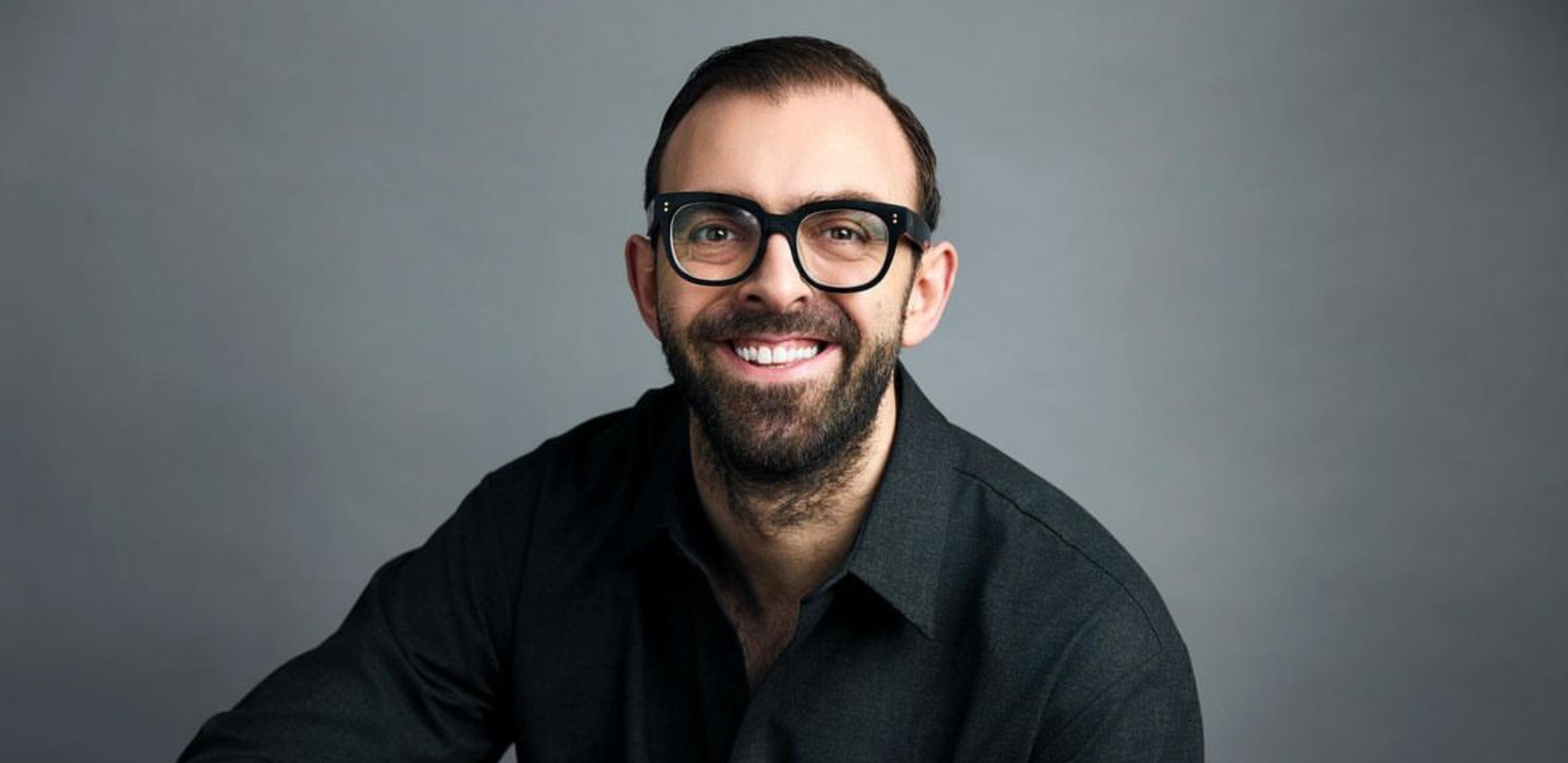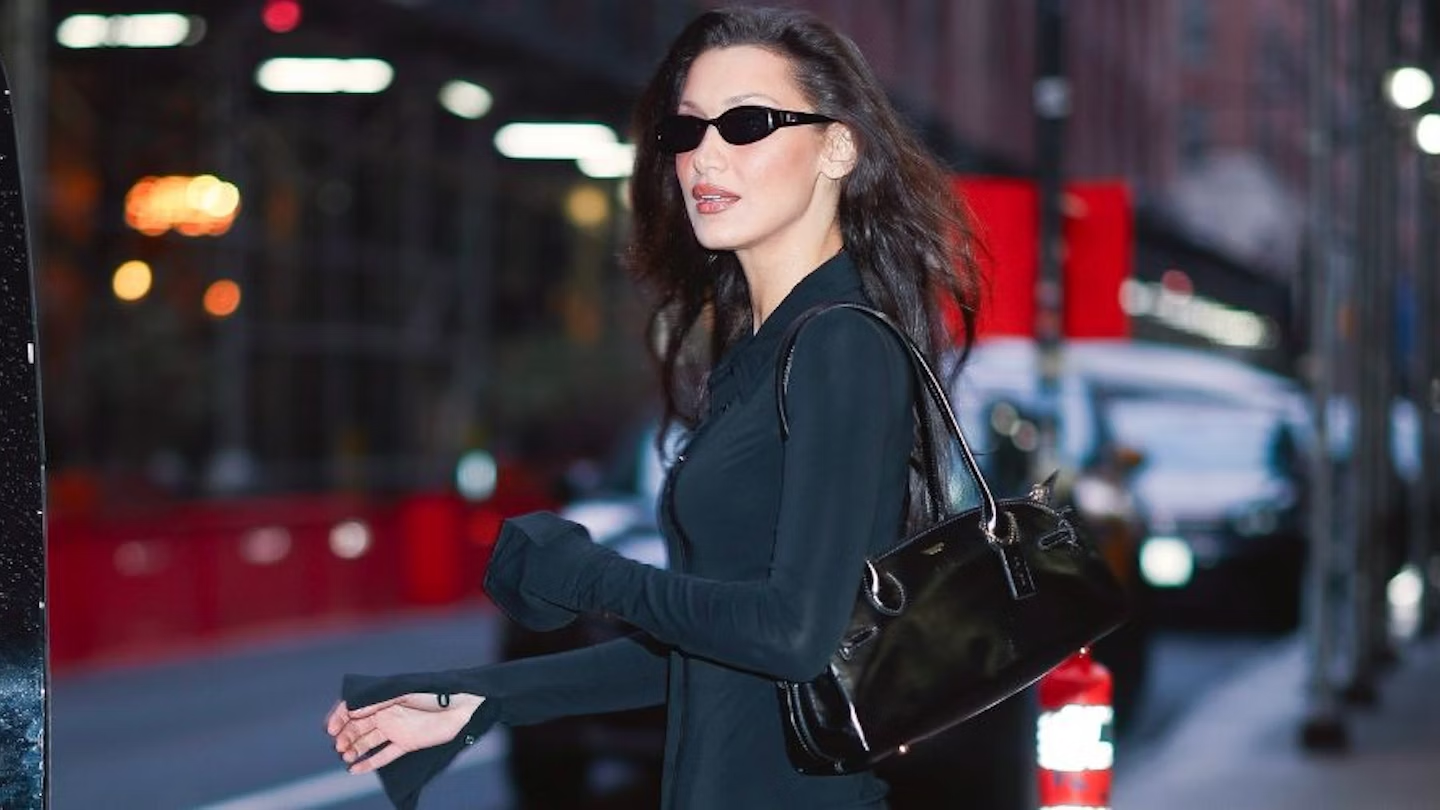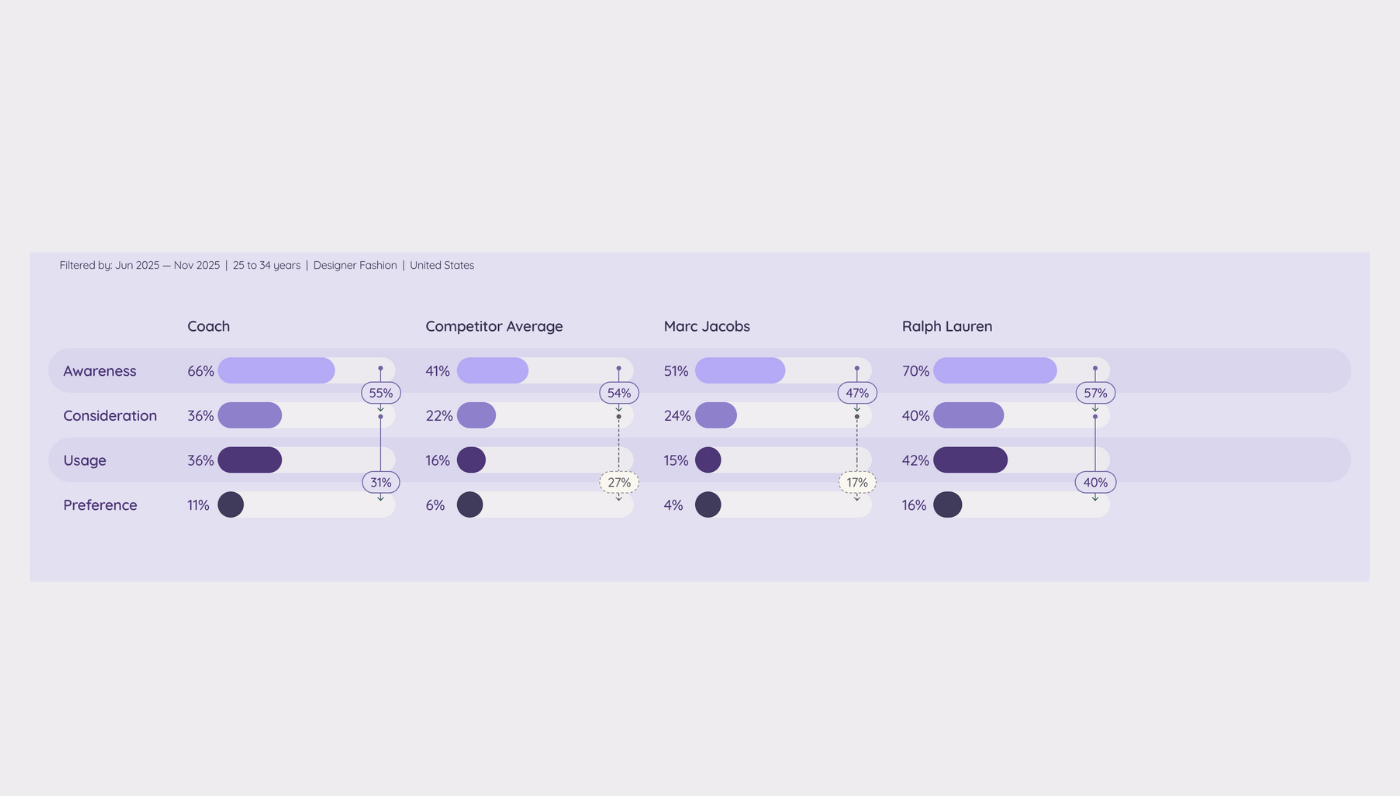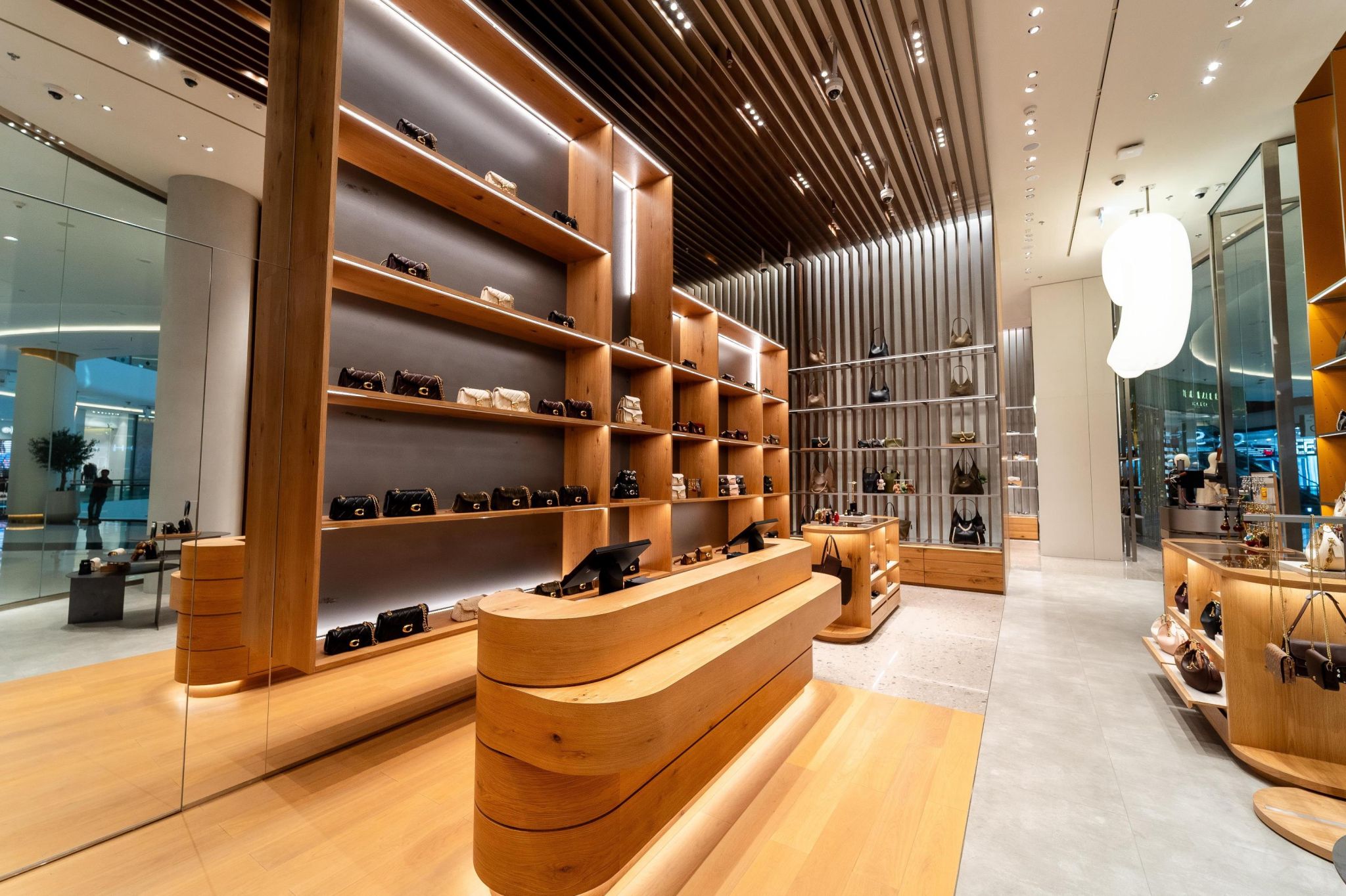
In paid partnership with Tracksuit. Data provided by Tracksuit; editorial control by THE GOODS.
NEW YORK—Giovanni Zaccariello looks almost exactly like his LinkedIn feed suggests he might: all black and charcoal, leather jacket, high-waisted trousers, the kind of strict palette that makes the glasses and grin do the talking. New York brick café energy, espresso in hand. But there’s nothing performative in the way he talks. The look might be ready for a campaign shot; the manner is more studio-floor, sleeves-rolled-up.
Zaccariello has spent the past 15 years at Coach, where he is now senior vice president of global visual experience. In practice, that means he is responsible for almost everything a customer feels when they step into a Coach space or scroll past a Coach moment: the Tabby hot-air balloon drifting over Taiwan, the “Coach Play” community stores in Osaka, the airport restaurant in Singapore, the new Expressive Luxury concept in Dubai Mall with its glowing “C” portal and warm wood interior, and the endless stream of oversized bags, colour-blocked façades and local pop-ups.

Serving alongside creative director Stuart Vevers, CEO Todd Kahn and CMO Joon Silverstein, Coach has quietly become one of the hottest brands in fashion again, ranked fifth on the Lyst Index for Q2 this year, sitting alongside Saint Laurent, Miu Miu and The Row. Why? For fifth place ranking, Lyst notes Coach announced multiyear WNBA partnership and highlighted five new draftees. Also, counting to the status was their launch of the Soho Sneaker campaign featuring Charles Melton and a Gen Z cast. And debuting the Winter 2025 collection with layered tailoring and reimagined archival bags; Tabby and Brooklyn bags seen on Camila Morrone, Bella Hadid, and more.

More than 60 percent of new customers are Gen Z or millennials, and demand is being driven by “expressive luxury” – a strategy that puts younger consumers’ self-expression at the centre of everything from leather sourcing to store design.

Tracksuit brand-health data backs it up. Among US 18 to 24 year olds, Coach beats the designer-fashion average at every stage of the funnel: awareness sits at 63 percent versus the competitor average 38 percent. Consideration at 38 versus 21, usage at 30 versus 13 and preference at 13 versus 6.

The same pattern holds with 25- to 34-year-olds, where Coach matches or outperforms peers like Marc Jacobs and Ralph Lauren. For a brand once dismissed as “my mother’s bag,” that is a sharp generational reset.
Internally, that reset has been framed as “flipping the script.” Coach have gone from a brand for everyone to a brand built around Gen Z; from seeing consumers as buyers to understanding them as humans; from fighting for retention to winning at acquisition; from over-reliance on performance marketing to brand-first investment; from short-term sales to longer-horizon signals; from product-led to purpose-led under the “Courage to Be Real” platform; and from “more is more” to focus and scale, with icons like the Tabby bag doing long-term heavy lifting. Gio’s world – the stores, the experiences, the images that live in people’s heads – is where those flips become tangible.

If you follow Zaccariello online, you know he is one of the rare executives who seems to enjoy narrating the process. One week he is on stage in Singapore with 800 store managers, talking “our strategies, our consumer and a look ahead into 2026.” The next he is thanking the team in Chengdu for “cute local guerrilla activations” with supersized Tabby shoppers, or walking through a Tapestry conference deck about visual experience as “the silent seller,” where “blending ‘Magic & Logic’ has been key.”
I wanted to know what it looks like to run that machine from the inside – and what a brand leader might learn from someone who thinks about store windows, Roblox, Gen Z’s bedroom shelves and airport restaurants as one continuous canvas.
Most of it wasn’t planned. You think you want a crystal ball for your career, but life doesn’t work like that.
What I know for sure is that I couldn’t do what I do today without those moves. Coach really is a global brand, and living in the European market, the Asian market and now the American market gives you a much broader approach to what retail actually looks like. There are similarities, but more important, there are differences – and in my role, we celebrate those.
Even within Europe, Italy, London and Amsterdam are incredibly different. Asia is the same. When I moved to Hong Kong 15 years ago to lead visual merchandising for Asia-Pacific, I was the expat managing Japan, Korea, Singapore – the whole region.
I decided to live not in the centre, but where the locals lived in Hong Kong to be able to experience exactly what life was about. So that I could understand how my peers would operate and work and I learned it is much more of a family style, very similar to Italy; More similar to Italy than the US.
I was a sponge. I was literally getting myself educated on a daily basis on customs, traditions and most importantly how to do business and how you manage teams.
Those years gave me two big things: humility and curiosity. You realise you don’t know it all, no matter your level in the company. You’re always a learning book. And they taught me to take risks. Moving from Europe to Hong Kong was a big risk. I didn’t know it then, but that appetite for risk is now a big part of how we do experiential at Coach. If you don’t try, you don’t know. If you don’t try, you can’t fail and learn.
New York was always a dream, but it wasn’t on some five-step plan. I didn’t move to Hong Kong thinking, “Then I’ll go to New York.”
What made the difference was knowing the transformation Coach was about to begin. It felt like the right time. So I said yes, moved, and never looked back. I’ve been here more than ten years now. It’s home.
You know what? I rarely repost because I want to add my own spin and I want what I share to be true to the experience. Coach is doing so much in the world of experiential that even inside the company people sometimes don’t know what’s happening.
So I use LinkedIn for a few reasons. First, to congratulate the teams around the world. Most of the time I’m not there in person, but some of those experiences take a year to design and build. Posting is a way to be there virtually and say thank you – to our internal teams and to the production partners who spend months building these stories.
Second, it’s a way to connect to other creative leaders. Off the posts, there are so many conversations. We mentor each other. It’s become a creative network.
I’m not doing it to show off by any means. People inside Coach think I have an assistant running it. I really don’t. It’s all very personal, not pre-planned. I’ll spend time thinking about what I want to say, but it’s organic and natural.
And then there are the students. I get a lot of messages from people trying to find their way into fashion or into creative roles. For them it’s a bit of a treasure hunt: “How do I learn? How do I enter this world?” If my posts can help demystify how experiences are made, that’s worth the time.
When I first moved to New York, the team was called visual merchandising. We built guidelines, directives, windows. We merchandised the stores.
As we started building emotional connection with Gen Z, especially after the pandemic, that wasn’t enough. People had been stuck indoors and wanted to come back together. It was the right moment to expand from visual merchandising to visual experience.
What changed is that we brought more teams under one umbrella. We added 3-D designers, graphic designers, the events and runway teams, production – and most recently the digital team that translates everything we do physically into a game, an AI experiment, a Roblox world.
Now the team connects physical and digital and puts the Gen Z consumer at the heart of everything. When those teams sit together, you really are blending magic and logic. From the outside, the consumer doesn’t know who does what, and they don’t need to. What they feel is that there is one vision.
It also means more brains in the room. If one creative is working alone, that’s one type of idea. When you have a group of ten brainstorming, it’s a different world – and much more fun. We pride ourselves on that. The projects can be laborious and pressured, but the fun is a component I would never underestimate.
The Coach Tabby shop, absolutely. We’re now in our fourth year of Tabby. The first two years were experiments; the last two have been about consistent concept. The Coach Tabby shop is very simple for the customer to understand, and now you see them popping up all over the world.
We have some constants: there’s always an oversized 3-D Tabby bag you cannot miss, a unified yellow that feels heritage and optimistic, and a co-creation bar. That co-creation bar has been a huge success, especially with Gen Z. You can self-express with tags, charms, little jewellery pieces. Every season it evolves.
What we do now is keep that base – the big 3-D bag, the colour, the co-creation – and connect it locally through events and activations. The 3-D object might be the same in every country, but what happens around it is different in China for Lunar New Year, in the Middle East for Ramadan, in the U.S. for the holidays. That’s the global-local conversation for us.

It actually wasn’t in the plan. At Tapestry, one of our leadership competencies is “What if?” – meaning, think outside the box and take the biggest risk you can imagine.
A few of us were sketching one day: what if we did a boat in the shape of a Tabby? What if…and then, what if we could do a balloon? The Taiwan team found this incredible hot-air-balloon festival, and that was the unlock. If we did the balloon as a random stunt, it would just be a shiny object on social media for two days. We wanted to be part of a cultural moment in Taiwan.
So we married the regional reality with the creative idea, instead of just dropping a big photo op into the world. Online, the reaction was crazy. People wanted it in every country, but something like that you do once. It’s too special to repeat. What you will see is more Tabby, with more local nuance, in the next seasons.
First, the creative team is very embedded in the business. We don’t build shiny objects. Our target is clear: Gen Z. Everything we do is aimed at them.
When we start a creation meeting, I always say, “No idea is a bad idea.” And I mean it. There can be a tiny seed in something that another person can grow. That comfort level is important.
Second, I protect creative time. In my team, people are not in meetings all day. You rarely come up with an idea in a meeting. You need your own time, and you need to be out in the world. We travel a lot – exhibitions, shows, meeting vendors. We spend time on social media to see what’s out there. The world is huge, but with your phone you can be anywhere at any time.
My role is to bring all of that together. I see myself more as a generalist than a specialist. The team is full of specialists. When they are together and we all see the same idea from different angles, that’s when you feel the click. Sometimes we just look at each other and go, “Oh my, that’s a big idea.” Lately that’s been happening quite often, which tells me the team is very inspired by Stuart’s [Vevers] vision and by what’s happening at Coach.
We also have something called the “creative fridge.” When we have ideas and don’t know what to do with them, we put them in the fridge. Later, when we’re in a rush, we open the fridge and see what’s there. It’s incredibly inspiring. Sometimes we even schedule an hour just to go through it. You forget how many good ideas are already waiting for their moment.
Every day is different, but there are some non-negotiables. I’m a morning bird, which helps. I wake up very early and usually connect with the Asia team before the sun rises here. We have a lot of projects there, so I want to make sure that world is up and running.
Five to six-thirty a.m. is sacred. That’s my me-time. I speak to my parents in London every day. I go to the gym every morning to get into the right mood for the day. I’m in the office by 7:30 or 7:45.
I try to use the morning for creative work: workshops, team meetings, anything that needs 100 percent attention. After lunch is more operational – project work, follow-through. In the morning everyone has had their coffee, the energy is positive, and that’s when the best ideas come to life.
I also try to take two 15-minute breaks a day. Sometimes I walk the High Line – we’re lucky, it’s nearby – or I go downstairs for another coffee. You need those moments to recalibrate, think about the meetings you’ve had and prepare mentally for what’s next.
One thing I believe strongly: having a packed calendar is not efficient. If you go from meeting to meeting, you have no time to do the work. You need the guts to opt out of meetings where you’re not adding value. Your time is valuable. And then you need moments where you can just sketch. Sometimes an idea comes and I’ll block 30 minutes, sit down and draw. If you don’t capture it, you lose it.
Ideas also come all the time – at exhibitions, running in the park, on a SoulCycle bike, at dinner with friends. I’m always taking pictures of random things. People ask, “Why that?” It just means something to me, and later it becomes something else.
And I really believe creative people need time to do nothing. The power of solitude is real. Stuart and I often joke that you can’t flip a switch and say, “Now I’ll have an idea.” You have to create the environment for ideas to show up.
A lot of people might not realise it, but there’s a tremendous amount of consumer insight behind what we do. We work closely with data analytics teams to understand the Gen Z mindset. Many of my team members have been inside Gen Z homes – literally – to see how they live, how they shop, what their lifestyle looks like. We’re not designing in a vacuum.
We also stay close to our regional execution teams because they’re part of the same visual experience group. They see the consumer on the ground every day. So from concept to testing to final store openings, the consumer is at the heart of it.
CMO, Joon Silverstein recently explained it as a need to ‘shift from seeing consumers as buyers to understanding them as humans: hundreds of hours in their homes, not asking what they buy but learning about their lives, aspirations and tensions.’
Visual experience means not designing for a theoretical persona, ‘designing for a 19-year-old in Seoul who loves self-expression but cares about sustainability, or a 22-year-old in Chicago whose “third place” is a coffee shop and a Roblox server.’
Coach Play is really our laboratory. It’s a series of fully immersive stores we’ve designed and opened around the world – we have 12 now, with more coming. On Instagram and LinkedIn I’ve described them as leaning into the five senses and local community, and that’s exactly it. From the outside they signal, very clearly, “This is a brand for you.”
We see two big things in the data. First, a higher number of Gen Z crossing the lease line. They see the façade, the graphics, the energy, and they walk in. Once inside, the price point feels reasonable for their wallet. Second, dwell time is four to eight times higher than in a regular store. That depends on layout, the sense of discovery and what there is to do – play a game, have a coffee, customise a bag.
They’ve become a third space. People hang out there. Whether they buy a Tabby the first time doesn’t matter. They’re spending time with the brand, talking to store staff, and coming back with friends. That’s community.
The restaurants are part of the same idea: Coach as a lifestyle, not just a product. Bringing a little “NYC energy” to an airport in Singapore, for example, is about more than a logo on a sign. It’s atmosphere, food, music. It’s how you feel sitting there.
We’re learning a lot from Coach Play and these hospitality experiments, and the next step is figuring out how to scale those learnings across the more classic network.
From my perspective, it’s the alignment. We have a clear vision around “expressive luxury” – timeless pieces that allow self-expression – and a leadership team that is truly consumer-centric.
Visual experience can only do its job if product, storytelling and commercial strategy are in sync. When Stuart puts Gen Z on the runway in scuffed trainers and shrunken T-shirts, when the company invests in recycled leather and circularity for Coachtopia, when the merchandising teams lean into Tabby for multiple seasons instead of chasing every micro-trend – all of that gives my team a strong backbone to build on.
You can feel it in the reaction. Gen Z is responding not just to a bag but to a world. And when you look at the data you see that world turning into durable behaviour.
Be a sponge. Keep learning. Stay curious. Accept failure when it comes, because you’re not going to learn by being perfect every day – and in retail, perfection doesn’t exist. The consumer is moving too fast for us to have all the answers.
Be inquisitive. Ask questions. Travel. Go to places where you don’t “belong” and learn from them, because ideas and innovation can come from anywhere. Get educated on all fronts – culture, business, technology, not just design.
And remember: no idea is wasted. It might just need some time in the fridge.
—
What does an ideal day look like when you’re Coach's SVP Global Visual Experience & Store Design?
“I have friends everywhere because I’ve lived everywhere,” Zaccariello says at the close of our conversation, “so I try to visit them around the world.” His last personal trip was to Bali, five days in the middle of the jungle after a long work stretch. “Your brain needs a break. When you come back, you’re enriched and you’re stronger for more ideation and more work.”
He leans toward remote places, sometimes with friends, sometimes alone. And when I ask for the destination that changed him the most, he doesn’t hesitate: India. “I took a two-week trip last year and it really changed my life. The culture, the food, the architecture, the humility, it was one of the best places I’ve been. You can’t go for just a week. You have to immerse.”